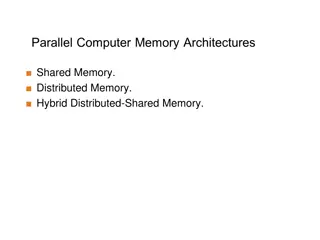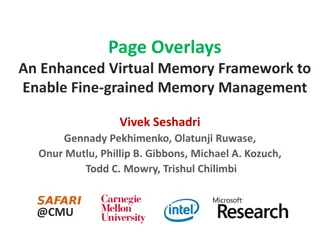A Framework for Memory Oversubscription Management in GPUs
Memory oversubscription in GPUs leads to performance degradation or crashes, necessitating the development of application-transparent mechanisms like the ETC framework. This framework incorporates eviction, throttling, and compression techniques to improve GPU performance across various applications, outperforming existing methods.
Download Presentation

Please find below an Image/Link to download the presentation.
The content on the website is provided AS IS for your information and personal use only. It may not be sold, licensed, or shared on other websites without obtaining consent from the author.If you encounter any issues during the download, it is possible that the publisher has removed the file from their server.
You are allowed to download the files provided on this website for personal or commercial use, subject to the condition that they are used lawfully. All files are the property of their respective owners.
The content on the website is provided AS IS for your information and personal use only. It may not be sold, licensed, or shared on other websites without obtaining consent from the author.
E N D
Presentation Transcript
A Framework for Memory Oversubscription Management in Graphics Processing Units ` Chen Li, Rachata Ausavarungnirun, Christopher J. Rossbach, Youtao Zhang, Onur Mutlu, Yang Guo, Jun Yang 1
Executive Summary Problem: Memory oversubscription causes GPU performance degradation or, in several cases, crash Motivation: Prior hand tuning techniques require heavy loads on programmers and have no visibility into other VMs in the cloud Application-transparent mechanisms in GPU are needed Observations: Different applications have different sources of memory oversubscription overhead ETC: an application-transparent framework that applies Eviction, Throttling and Compression selectively for different applications Conclusion: ETC outperforms the state-of-the-art baseline on all different applications 2
Outline Executive Summary Memory Oversubscription Problem Demand for Application-transparent Mechanisms Demand for Different Techniques ETC: An Application-transparent Framework Evaluation Conclusion 3
Memory Oversubscription Problem DNN training requires larger memory to train larger models Cloud providers oversubscribe resource for better utilization Limited memory capacity becomes a first-order design and performance bottleneck 4
Memory Oversubscription Problem Unified virtual memory and demand paging enable memory oversubscription support Memory oversubscription causes GPU performance degradation or, in several cases, crash 5
Outline Executive Summary Memory Oversubscription Problem Demand for Application-transparent Mechanisms Demand for Different Techniques ETC: An Application-transparent Framework Evaluation Conclusion 6
Demand for Application-transparent Framework Prior Hand-tuning Technique 1: - Overlap prefetch with eviction requests Hide eviction latency Prefetch Eviction 7
Demand for Application-transparent Framework Prior Hand-tuning Technique 2: - Duplicate read-only data Reduce the number of evictions Duplicate read-only data instead of migration No need to evict duplicated data Drop duplicated data instead 8
Demand for Application-transparent Framework Prior Hand-tuning Techniques: - Overlap prefetch with eviction requests - Duplicate read-only data Requires programmers to manage data movement manually No visibility into other VMs in cloud environment Application-transparent mechanisms are urgently needed 9
Outline Executive Summary Memory Oversubscription Problem Demand for Application-transparent Mechanisms Demand for Different Techniques ETC: An Application-transparent Framework Evaluation Conclusion 10
Demand for Different Techniques Different Applications behave differently under oversubscription 100% of Application's Footprint 2 Runtime Normalized to >1000X >1000X 75% of application's footprint 1.75 1.5 50% of application's footprint 1.25 1 0.75 Crashed Average 17% performance loss 0.5 0.25 0 2DCONV 3DCONV RED ATAX MVT Collected from NVIDIA GTX1060 GPU 11
Demand for Different Techniques Representative traces of 3 applications Regular applications with no data sharing Regular applications with data sharing Irregular applications 3DCONV LUD ATAX Hiding Eviction Latency; Reducing data migration Hiding Eviction Latency Reducing working set size Streaming access Small working set Different techniques are needed to mitigate different sources of overhead Data reuse by kernels Small working set Random access Large working set Moving data back and forth for several times Waiting for Eviction Thrashing 12
Outline Executive Summary Memory Oversubscription Problem Demand for Application-transparent Mechanisms Demand for Different Techniques ETC: An Application-transparent Framework Evaluation Conclusion 13
Our Proposal Application-transparent Framework Proactive Eviction Classification Application ETC Framework Memory-aware Throttling Capacity Compression 14
Application Classification Sampled coalesced memory accesses per warp LD/ST Units < threshold > threshold Regular applications Irregular applications Compiler-information No data sharing Data sharing 15
Regular Applications with no data sharing Waiting for Eviction Proactive Eviction Demand Pages Evicted Pages First page fault detected GPU runs out of memory Page A Page B Page C Page D Page F Page H Page J Page L CPU-to-GPU (a) Baseline GPU-to-CPU Page E Page G Page I Page K time Key idea of proactive eviction: evict pages preemptively before GPU runs out of memory Page A Page B Page C Page D Page F Page H Page J Page L Proactive Eviction CPU-to-GPU (b) GPU-to-CPU Saved Cycles Page E Page G Page I Page K Page M 16
Proactive Eviction Not Enough Space Evict a Chunk Allocate a New Page Page Fault Enough Space Fetch a New Page App Classification App Type: Regular Proactive Eviction Evict A Chunk Virtual Memory Manager Memory Oversubscribed Available Memory Size < 2MB ETC Implementation 17
Regular Applications with data sharing Waiting for Eviction Proactive Eviction Moving data back and forth for several times Capacity Compression Key idea of capacity compression: Increase the effective capacity to reduce the oversubscription ratio Implementation: transplants Linear Compressed Pages (LCP) framework [Pekhimenko et al., MCIRO 13] from a CPU system. 18
Irregular Applications Memory-aware Throttling Thrashing Key idea of memory-aware throttling : reduce the working set size to avoid thrashing Reduce concurrent running thread blocks Fit the working set into the memory capacity 19
Memory-aware Throttling Throttle SM Page eviction detected 4 1 5 Page fault detected 3 Detection Epoch Execution Epoch No page eviction 2 Release SM Time expires with no page fault ETC Implementation SM Throttling 20
Irregular Applications Memory-aware Throttling Capacity Compression Thrashing Lower Thread Level Parallelism (TLP) Lower Thread Level Parallelism 21
ETC Framework Regular applications with no data sharing Proactive Eviction Regular applications with data sharing Memory-aware Throttling Capacity Compression Irregular applications No single technique can work for all applications 22
ETC Framework Application-transparent Framework App starts Oversubscribing memory All Regular App Compiler Proactive Eviction All Irregular App GPU Runtime Memory-Aware Throttling APP Classification GPU Hardware Data Sharing Regular App All Irregular App Capacity Compression Memory Coalescers 23
Outline Executive Summary Memory Oversubscription Problem Demand for Application-transparent Mechanisms Demand for Different Techniques ETC: An Application-transparent Framework Evaluation Conclusion 24
Methodology Mosaic simulation platform [Ausavarungnirun et al., MICRO 17] Based on GPGPU-Sim and MAFIA [Jog et al., MEMSYS 15] Models demand paging and memory oversubscription support Real GPU evaluation NVIDIA GTX 1060 GPU with 3GB memory Workloads CUDA SDK, Rodinia, Parboil, and Polybench benchmarks Baseline BL: the state-of-the-art baseline with prefetching [Zheng et al., HPCA 16] An ideal baseline with unlimited memory 25
Performance ETC performance normalized to a GPU with unlimited memory Compared with the state-of-the-art baseline, Performance Normalized 75% BL 75% ETC 50% BL 50% ETC Regular applications with no data sharing to Unlimited Memory 1.2 6.1% 3.1% 1 102% Fully mitigates the overhead 59.2% 0.8 436% 0.6 61.7% Regular applications with data sharing 60.4% of performance improvement 0.4 0.2 0 Regular apps (no data sharing) Regular apps (data sharing) Irregular apps Irregular applications 270% of performance improvement 26
Other results In-depth analysis of each technique Classification accuracy results Cache-line level coalescing factors Page level coalescing factors Hardware overhead Sensitivity analysis results SM throttling aggressiveness Fault latency Compression ratio 27
Outline Executive Summary Memory Oversubscription Problem Demand for Application-transparent Mechanisms Demand for Different Techniques ETC: An Application-transparent Framework Evaluation Conclusion 28
Conclusion Problem: Memory oversubscription causes GPU performance degradation or, in several cases, crash Motivation: Prior hand tuning techniques require heavy loads on programmers and have no visibility into other VMs in the cloud Application-transparent mechanisms in GPU are needed Observations: Different applications have different sources of memory oversubscription overhead ETC: an application-transparent framework that Proactive Eviction Overlaps eviction latency of GPU pages Memory-aware Throttling Reduces thrashing cost Capacity Compression Increases effective memory capacity Conclusion: ETC outperforms the state-of-the-art baseline on all different applications 29
A Framework for Memory Oversubscription Management in Graphics Processing Units Chen Li, Rachata Ausavarungnirun, Christopher J. Rossbach, Youtao Zhang, Onur Mutlu, Yang Guo, Jun Yang 30























